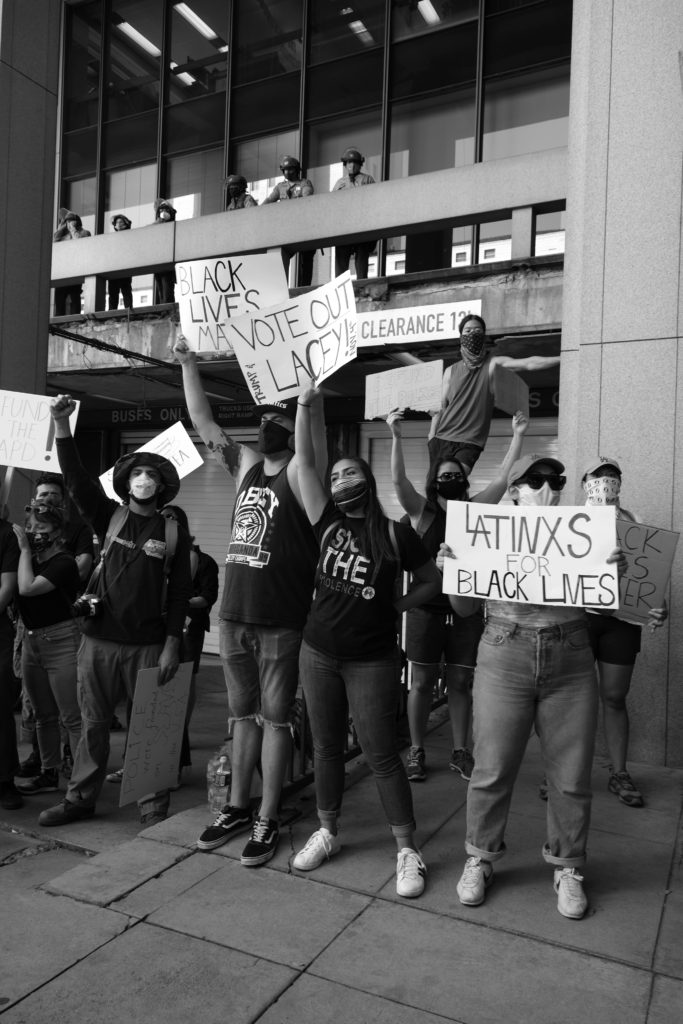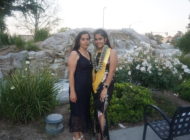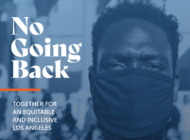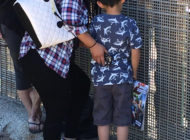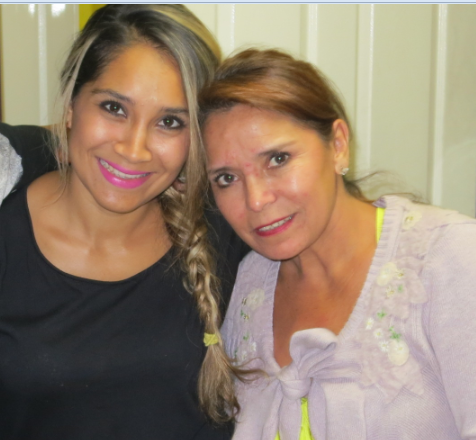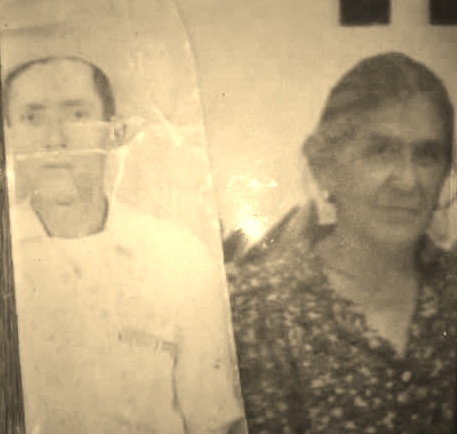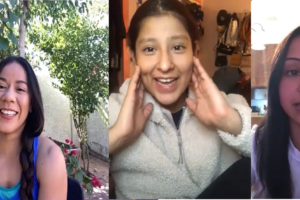Media coverage of black-brown relations is much more than positive or negative, and the stand journalists take on the topic can impact Latino and Chicano support for the current Black Lives Matter Movement.
By RAYLEEN SILVA
EL NUEVO SOL
As I walked through my school and passed the same buildings I’ve walked by the last four years, tears began to fill my eyes. I walked by the university bookstore and continued toward the street. As I regained my voice, I started to scream with the other protesters, “I. Can’t. Breathe.”
Overwhelmed, I decided to distract myself by reading the signs of the protestors around me— Latinos for BLM, Chicanos for Black Lives.
I saw people from the Latino and Chicano community show up and support the BLM movement, yet I did not see it reflected in the media. Instead, I saw articles questioning whether they would support the BLM movement and saying they need to address their inherent racism.
The first protest I attended was on June 2, 2020, and it took place in one of the most familiar places for me, my school– California State University Northridge.
On May 25, 2020, a black man named George Floyd was murdered. Floyd was killed by Minneapolis police as one of the officers kneeled on his neck for over eight minutes as Floyd cried out, “I can’t breathe.”
The world erupted in protest after his death was caught on camera, and he became another martyr for the Black Lives Matter (BLM) movement.
“I think the problem that I have sometimes with those articles though, is they sometimes feel to be a little blamey,” said Brian D. Behnken, editor of the book, The Struggle in Black and Brown: African American and Mexican American Relations During the Civil Rights Era. “They are pointing the finger. I think sometimes blaming and pointing fingers isn’t the best way to go if you’re interested in doing that for the sake of coalition building. It can sometimes make people feel like you’re attacking them.”
Media organization’s simplistic view of black-brown relations negatively impacts the Black Lives Matter movement because it creates tension when they disproportionately report on black-brown disunity.
“I can’t tell you the number of news articles that I read that basically ask that question, “Will Latinos join? Will Latinos participate? Are Latinos down with black lives matter,” said Behnken. “There was a part of me that read those things and was just kind of like, ‘What the [expletive]?’ All you have to do is go out and go to a protest, and you are going to see those communities and those faces represented.”
With the recent explosion of support for the BLM movement, black-brown relations have become a relevant topic in the news.
Latino Support for BLM
According to an article by Álvaro Corral, “Allies, Antagonists, or Ambivalent? Exploring Latino Attitudes about the Black Lives Matter Movement,” Latinos do not gain anything from anti-black beliefs in a system that oppresses both Latinos and Black people.
An article by the Hispanic Network Magazine interviewed the Chief Executive Officer of the League of United Latin American Citizens, Sindy M. Benavides, and she explained the impact the BLM movement has on Latinos. Benavides claims police brutality is an issue that affects black and brown communities, not to mention, many Hispanics identify as black or Afro-Latino.
“Most importantly, we know that their [BLM] success is our success and that it will benefit all communities who are targeted and marginalized,” said Benavides in the article.
The Media’s Impact on Black-Brown Coalition Building
In March 1968, in response to the late 1960s riots, the Kerner Commision Report was conducted, to find the cause of the urban riots, and one of the causes they found was the media’s portrayal of the black community.
The report stated that the media exaggerated the nature and scale of violence that occurred, and failed in communicating to their white audience why the “civil disorders” occurred in the first place.
They then recommended media organizations hire more black reporters, train non-black journalists to report on urban issues, and expand coverage of the black community and their issues.
An article by David Pritchard called “Racial Profiling in the Newsroom,” written in 2007 states that journalists of color are still underrepresented in the newsroom.
According to Behnken, reporters and scholars tend to focus on the disunity side of black-brown relations, and based on these statements from Pritchard, Behnken may not be wrong.
“You can’t expect the news media to cover something they don’t know about and that may not even exist,” said Pritchard in an interview. “When there is no black-brown cooperation, or white-black, or white-brown, that’s normal. But when there is black-brown cooperation, that’s unusual, and I would suspect people would tend to click on that because it’s unusual.”
When reporters write stories about black-brown unity and treat it as if it is uncommon, it can perpetuate the stereotype that the two groups do not get along. It is the same idea when reporters regularly write stories about black-brown disunity.

Phoenix, Arizona. Black Lives Matter March. Guy wearing Mexican Flag. Photo by Diego Lozano on Unsplash
Inclusivity
According to an opinion article in Business Insider, written by a sociology professor who studies protests and activism, the protests that occurred this summer were more diverse than ever before.
“It is inclusivity that crosses the lines of gender, sex, race, and ethnicity. They [BLM] have always said, we oppose police brutality, we’re using black lives because black people have been the ones that have been the most aggrieved by police brutality, police murder, and all of those things. But we will work with anybody we want to stop police brutality for everyone,” said Behnken.
When news organizations were filming or taking photos of protestors, to simply show the protests, it demonstrated how multiracial they were.
“The protests themselves have been inclusive, and I think maybe part of, if you’re looking at the media, what people might see when they see that is, ‘Oh if I go there it is gonna be okay. If I go there, it is gonna be acceptable.’ There is something communicated to those folks that this is okay for you,” said Behnken.
However, according to Corral, the media oversimplifies the relationship between the two communities.
“I think the solution might be to put those dichotomies away and say those are too simplistic and don’t really get us anywhere,” said Corral. “Regardless of whichever one you adopt for a story, it’s gonna do a disservice to the truth because that’s not the truth, period. It’s often both.”
Behnken questioned why journalists continue to focus on black-brown disunity and came to the conclusion that journalists have been taught to think of race relations in a conflicted way, and it is an easy story for them to tell.
All three men interviewed claim the history of black-brown unity is complicated, and media coverage of it is extremely important, relevant, and must be done correctly because of the impact it can have on the current Black Lives Matter Movement.
“Very often if you ignore a story about a group you deprive it of the oxygen it needs to live,” said Pritchard.
Tags: african americans Black Lives Matter Black-Brown relations BLM Chicanos Latinos







